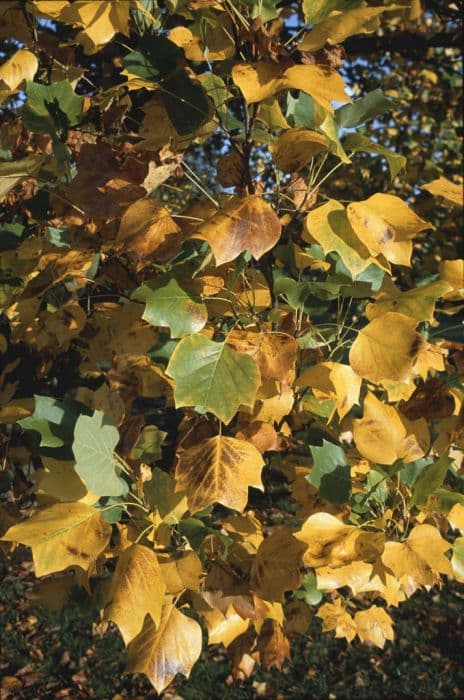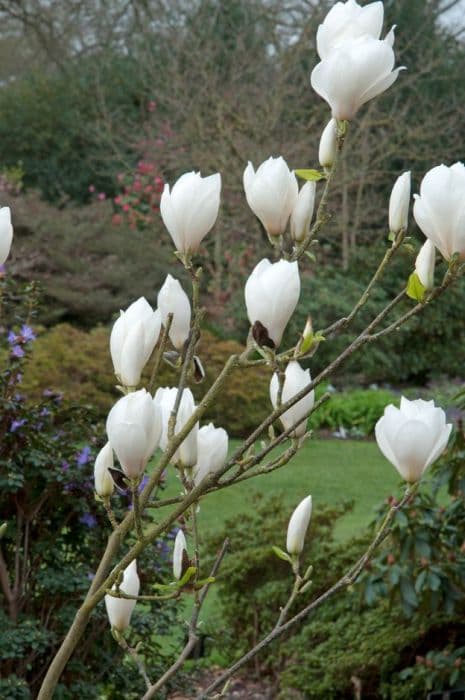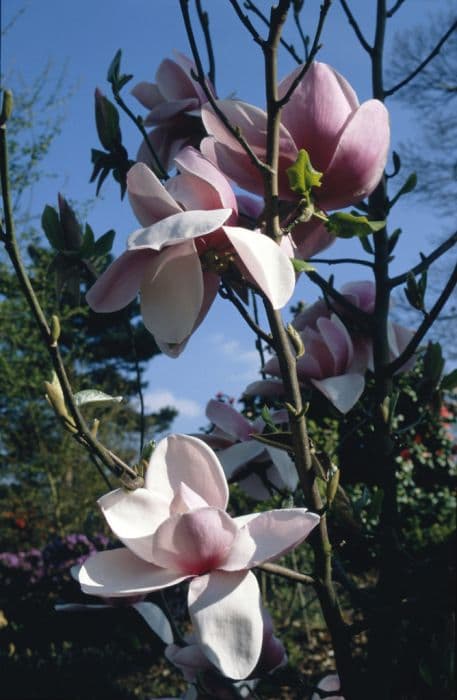Japanese Bigleaf Magnolia Magnolia obovata Thunb.

ABOUT
Magnolia obovata, commonly known as the Japanese bigleaf magnolia, is a striking plant known for its distinctive foliage and flowers. The leaves are quite large, spreading, and they have a broad, obovate shape, meaning they are wider near the tip and narrow near the base. They present a lush green color, which can bring a rich, verdant texture to the landscape throughout the season. The plant is particularly admired for its beautiful, fragrant flowers that bloom in late spring or early summer. These blossoms are creamy white, large, and cup-shaped, often with a slight hint of pink or purple at the base, and provide a spectacular display against the green backdrop of the foliage. The flowers are quite prominent and can attract attention from a distance even without consideration of the plant's size. Inside the bloom, there is an elegant arrangement of stamens and a central pistil that are often complemented with a light lemony scent, making the plant not only visually attractive but also pleasing to the sense of smell. After the flowering season, the plant produces cone-like fruiting clusters that mature in late summer to early fall, offering additional ornamental value. Throughout the year, the Japanese bigleaf magnolia exhibits a sturdy, branching form with a rounded canopy that contributes to its striking appearance in the landscape. It is a plant that commands presence with its broad leaves, spectacular blooms, and overall grandeur in appearance, providing a significant aesthetic contribution to gardens and parks.
About this plant
 Names
NamesFamily
Magnoliaceae.
Synonyms
Japanese Bigleaf Magnolia, Japanese Whitebark Magnolia, Japanese White Magnolia, Oyama Magnolia, Whitebark Magnolia.
Common names
Magnolia hypoleuca Siebold & Zucc., Magnolia obovata var. thunbergii Koidz., Magnolia praecocissima Koidz., Magnolia tomentosa Thunb., Yulania obovata (Thunb.) Spach.
 Toxicity
ToxicityTo humans
Japanese bigleaf magnolia is not widely recognized as a toxic plant to humans. There are no well-documented cases or specific symptoms of poisoning from ingestion of this plant's parts. However, as with many plants, individual sensitivities or allergic reactions could potentially occur. Consuming parts of the plant that are not typically regarded as edible, especially in large quantities, could result in stomach discomfort, nausea, or other digestive issues due to the plant's chemical compounds that are not meant for human consumption. It is always best to avoid eating parts of ornamental plants unless they are known to be safe for human use.
To pets
Japanese bigleaf magnolia is not commonly known to be toxic to pets. There is limited information regarding the toxicity of this specific plant species to animals. However, individual animals might display sensitivity or allergic reactions to plants that are not generally recognized as poisonous. As a precaution, it is advised to prevent pets from ingesting this plant, as they might experience mild gastrointestinal upset such as vomiting or diarrhea if they consume parts of it. If a pet shows any signs of distress after ingesting any part of the plant, it is recommended to consult a veterinarian.
 Characteristics
CharacteristicsLife cycle
Perennials
Foliage type
Deciduous
Color of leaves
Green
Flower color
White
Height
50 feet (15 meters
Spread
30 feet (9 meters
Plant type
Tree
Hardiness zones
5
Native area
Japan
Benefits
 General Benefits
General Benefits- Landscape Aesthetics: Magnolia obovata, commonly known as Japanese bigleaf magnolia, offers ornamental value with its large, lush green leaves and striking white to creamy flowers that can enhance the visual appeal of gardens and parks.
- Shade Provider: With its broad canopy, the plant can provide significant shade, creating cool, shaded areas in landscapes, which can be particularly beneficial in hot climates.
- Habitat for Wildlife: The plant serves as habitat and provides food for various wildlife species, including birds and pollinating insects like bees and butterflies, which are attracted to its flowers.
- Timber Production: The wood of Magnolia obovata is moderately heavy and hard, and it is sometimes used for furniture, building materials, and in carpentry for creating traditional Japanese items such as wooden vessels and utensils.
- Cultural Significance: In its native regions, it has cultural importance and is often used in traditional practices and festivals; for instance, its leaves may be used for wrapping food, symbolizing purity and freshness.
- Seasonal Interest: It provides seasonal interest with its spring to early summer blossoms, and in the fall, the foliage can turn yellow to bronze, adding to the seasonal color palette of the landscape.
- Aromatic Flowers: The flowers of the Japanese bigleaf magnolia produce a pleasant, subtle fragrance that can add a sensory dimension to gardens and outdoor spaces.
 Medical Properties
Medical Properties- Anti-inflammatory: Magnolia obovata has been reported to contain compounds that may reduce inflammation.
- Anxiolytic effects: Some components in the bark of Magnolia obovata may have potential to alleviate anxiety.
- Antioxidant activity: The plant has been found to have antioxidant properties which could protect cells from oxidative damage.
- Anti-tumor properties: Certain extracts from Magnolia obovata have shown anti-cancer activities in preliminary studies.
- Neuroprotective effects: There is some evidence suggesting that compounds in the plant can protect neuronal cells.
- Antimicrobial properties: The plant has been used to inhibit the growth of various microbes, indicating potential antimicrobial benefits.
- Anti-stress effects: Some components in the plant may help in reducing stress.
- Gastroprotective effects: Magnolia obovata may help protect the gastric lining and manage symptoms of digestive disorders.
 Air-purifying Qualities
Air-purifying QualitiesThis plant is not specifically known for air purifying qualities.
 Other Uses
Other Uses- The wood of the Magnolia obovata, commonly known as Japanese bigleaf magnolia, is valued for its fine texture and is used in woodworking and furniture making.
- Japanese bigleaf magnolia's large leaves are sometimes used in decorative arrangements or as natural wrapping material for fresh foods in traditional settings.
- Extracts from the bark may be used in the dyeing process to produce colors for fabrics. Although not as common, this practice taps into the plant’s natural pigmentation.
- The tree is planted in parks and gardens for its ornamental value, due to its impressive foliage and striking flowers.
- In some cultures, the petals of Japanese bigleaf magnolia are candied and used as a sweet garnish for desserts and culinary presentations.
- Woodworkers may also create musical instruments from the wood of Magnolia obovata, appreciating its resonant qualities.
- The fibrous bark can be processed to create a natural fiber paper, often used in traditional arts and crafts, such as calligraphy.
- Japanese bigleaf magnolia seeds sometimes serve as a food source for wildlife, including birds and small mammals, supporting ecosystem diversity.
- Landscape architects may utilize the species as part of erosion control strategies on hillsides or banks due to its robust root system.
- The fallen leaves of the magnolia tree can be gathered and used as mulch in gardens, providing a nutrient-rich layer that protects soil moisture and health.
Interesting Facts
 Feng Shui
Feng ShuiThe Magnolia tree is often used in Feng Shui for its strong yin energy and is believed to bring purity and nobility. It can be planted in the front yard to attract auspicious chi, or life energy, to the home. Its large, fragrant blossoms are thought to enhance romantic luck and improve relationships.
 Zodiac Sign Compitability
Zodiac Sign CompitabilityThe Magnolia tree is not used in astrology practice.
 Plant Symbolism
Plant Symbolism- Persistence: Magnolias are known for their ability to withstand harsh conditions, which makes them a symbol of persistence and endurance.
- Nobility: Due to its impressive appearance and stature, the magnolia is often associated with nobility and dignity.
- Feminine Beauty: With its delicate and showy flowers, magnolias are commonly used to represent feminine beauty and gentleness.
- Inherent Worth: The magnolia tree's long history and existence even before bees suggest that the tree has an inherent worth, just as individuals have, regardless of external factors.
- Purity: The magnolia's white flowers are frequently used in cultural ceremonies to signify purity or to represent a clean slate.
- Perseverance: Similar to persistence, the magnolia's ability to grow and bloom year after year symbolizes perseverance and resilience through life's challenges.
- Spiritual Connection: In some cultures, magnolias are considered to have a strong spiritual significance and are used to symbolize a connection to the divine or one's inner self.
 Water
WaterJapanese Bigleaf Magnolia requires moderate watering, with consistency being key for healthy growth. During the growing season in spring and summer, water the plant once a week with approximately 1.5 to 2 gallons of water per session, depending on the soil moisture and the weather conditions. In the winter months, reduce watering to every other week, ensuring the soil doesn't dry out completely. Overwatering can lead to root rot, so it's crucial to allow the top inch of soil to dry out before the next watering. If the plant is in a pot, ensure that there is good drainage to prevent water accumulation at the bottom.
 Light
LightJapanese Bigleaf Magnolia thrives in full sun to partial shade. The ideal location is one where the plant receives morning sunlight and afternoon shade, or dappled sunlight throughout the day, which helps to prevent the leaves from scorching. Avoid deep shade as it can lead to poor flowering and leggy growth.
 Temperature
TemperatureJapanese Bigleaf Magnolia is hardy and can generally withstand temperatures as low as 10 degrees Fahrenheit and as high as 100 degrees Fahrenheit. However, it flourishes best in a moderate climate with the ideal temperature range being between 50 and 80 degrees Fahrenheit. It is important to protect young plants from extreme cold by providing mulch or other insulation.
 Pruning
PruningPruning Japanese Bigleaf Magnolia is done primarily to remove dead or damaged branches, which helps prevent disease and encourages healthy growth. It should be pruned just after flowering to avoid cutting off next year's buds. Annual light pruning is enough to maintain its shape and health. The best time for pruning is in late summer or early fall, before the plant begins to set buds for the next season.
 Cleaning
CleaningAs needed
 Soil
SoilThe best soil mix for a Japanese Bigleaf Magnolia should be rich, well-draining, and have an acidic to neutral pH between 5.5-7.0. Incorporate organic material like compost or peat moss to improve soil structure and fertility. Mixing in perlite or coarse sand can enhance drainage.
 Repotting
RepottingJapanese Bigleaf Magnolias do not typically require frequent repotting. Repot them every 2-3 years or when the root system outgrows the current pot, to ensure continued growth and health.
 Humidity & Misting
Humidity & MistingJapanese Bigleaf Magnolias prefer moderate to high humidity levels. Aiming for a humidity range of 50% to 60% is ideal for this plant. Avoid placing it in excessively dry environments.
 Suitable locations
Suitable locationsIndoor
Ensure bright light, high humidity, and regular watering.
Outdoor
Plant in partial shade with moist, acidic soil.
Hardiness zone
5-8 USDA
 Life cycle
Life cycleMagnolia obovata Thunb., commonly known as Japanese bigleaf magnolia, begins its life cycle as a seed, which germinates in moist, well-drained soil after a period of stratification to overcome dormancy. Upon sprouting, the seedling develops a taproot and starts growing its first leaves, entering the juvenile vegetative stage as it establishes itself. As the plant matures, it enters the adult vegetative stage, developing a sturdy trunk and a broad canopy with large, obovate leaves. The magnolia reaches reproductive maturity after several years, producing fragrant, large white flowers in late spring or early summer, which are pollinated by beetles that are attracted to the flowers' strong scent and copious pollen. After pollination, the flowers develop into cone-like fruit aggregates that release red seeds when mature, which are then dispersed by gravity and animals. The life cycle continues as these seeds germinate to produce new plants, perpetuating the species.
 Propogation
PropogationPropogation time
Spring to Summer
The Japanese Bigleaf Magnolia, commonly known as Magnolia obovata Thunb., is best propagated by seed, although it can also be propagated by grafting or cuttings. The most popular method of propagation is by seeds. Fresh seeds gathered in the fall after the fruit has ripened are sown immediately in a cold frame. This is because the seeds have a short viability period and lose their germination capacity quickly if allowed to dry out. They undergo a warm stratification process for about three months at temperatures around 68 to 86°F (20 to 30°C), followed by cold stratification at about 41°F (5°C) for another three months. Seeds then typically germinate in the spring as temperatures rise. Seedlings are usually left to grow in their pots for their first year before being moved to their permanent location outdoors.









